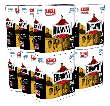There are times when, no matter how hard we try, calcium deposits simply "appear" on our cookware. Most often this phenomenon is noticed on stainless steel cookware. There are several methods that you can use to help in removing calcium deposits from cookware, though most of them require that you think outside the box a little bit. In fact, some of them may even seem a little counter intuitive, but they do work.
While these methods will work for a vast majority of calcium deposits, there is a chance that they won't as well. That situation is usually due to the metal becoming so pitted from use that there really isn't anything that you can do to restore the damaged steel pot. It is best to avoid such a situation by preventing it from happening at all. Do this by being careful with the amount of salt that you use in your cooking, and if at all possible avoid adding salt at all. If you do need to add any salt, only add it after the water has stopped boiling.

Tough Cleaning Jobs Require Brawny! Brawny paper towels provide the versatility you need: the strength for demanding jobs and the softness to clean up your child's messy face. This 24-roll pack of pick-a-size sheets can handle just about every cleaning task in your home. Check out Brawny 24-Pack Giant Paper Towels today!
What is keeping you from using that beautiful fine china that is neatly stacked and safely stowed away in the back of ...
Discover MoreDishwashers just can't tackle the cooked on food that collects on skillets. To take this disgusting mess out of your ...
Discover MoreSilverware should be cleaned fairly regularly, at least 3 times per year. It doesn't take very much time to keep your ...
Discover MoreFREE SERVICE: Get tips like this every week in Cleaning Tips from Tips.Net. Enter your address and click "Subscribe."
There are currently no comments for this tip. (Be the first to leave your comment—just use the simple form above!)
FREE SERVICE: Get tips like this every week in Cleaning Tips from Tips.Net. Enter your address and click "Subscribe."
Copyright © 2024 Sharon Parq Associates, Inc.
Comments